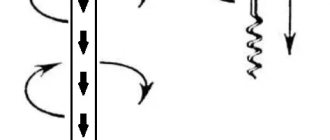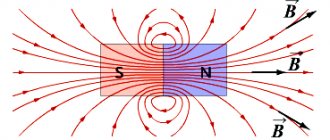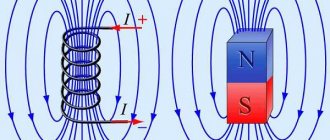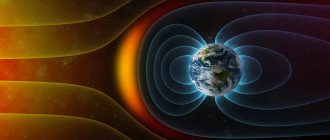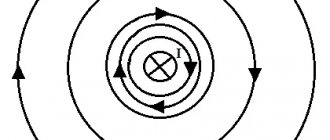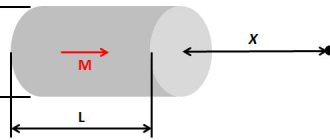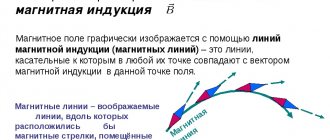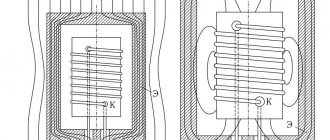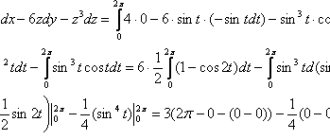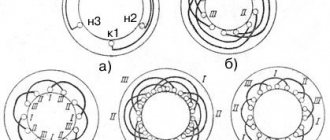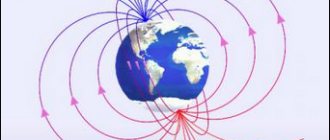Historical reference
The history of magnetism goes back to ancient times, to the ancient civilizations of Asia Minor. It was on the territory of Asia Minor, in Magnesia, that rocks were found, samples of which were attracted to each other. Based on the name of the area, such samples began to be called “magnets”.
And another 2600 BC. Chinese Emperor Hwang Ti led his army in thick fog with the help of a magnetic figurine that, turning around its axis, always looked south. This, as you might guess, was a kind of prototype of the first compass. Already from the second century AD. In China, permanent magnets were manufactured that retained magnetic properties for a long time. And in the 13th century they learned about magnets and the compass in Europe.
Figure 1. First compass
The first scientific study of the properties of a magnet was undertaken in the 13th century by the French scientist Peter Peregrin. In 1269, his work “The Book of the Magnet” was published, where he wrote about many facts of magnetism: that a magnet has two poles, which the scientist later called north and south, and that it is impossible to separate the poles from each other by breaking . Peregrine also wrote about two types of interaction between poles - attraction and repulsion.
Figure 2. Interaction of two magnets
And in 1600, the essay “On the Magnet” by the English court physician and physicist William Gilbert was published. To the already known facts, Gilbert added such important observations as: strengthening the action of magnetic poles by iron reinforcement, loss of magnetism when heated, and others.
Figure 3. William Gilbert
However, it was only in the 19th century that the connection between electricity and magnetism was discovered, and the idea of a magnetic field arose.
In 1820, the Danish physicist Hans Christian Oersted (1777-1851) discovered that a magnetic needle located next to an electrical conductor is deflected when current flows through the conductor, i.e., a magnetic field is created around the current-carrying conductor.
His experience was of great importance for the development of the doctrine of electromagnetic phenomena.
Figure 4. Oersted's experiment
And having learned about Oersted's work, the French physicist Andre Marie Ampere studied the interaction of parallel conductors with current. He established that if there are multidirectional currents in conductors, the conductors repel each other. And if the currents have the same direction, then the conductors will attract.
Figure 5. Ampere's experiment
These were the two most famous experiments in the history of magnetic field research, which prompted other scientists to do more and more research in this area.
Let's consider the nature of the magnetic properties of substances
Electrons in the shell of matter atoms move in different orbits. For simplicity, these orbits are considered circular, and any electron orbiting the nucleus of an atom can be considered a circular electric current. Like a circular current, each electron generates a magnetic field, which we call an orbital field. In addition, an electron in an atom has its own magnetic field, called spin.
If, when introduced into an external magnetic field with induction B < B0, induction B < B0 is created inside a substance, then such substances are called diamagnetic (n < 1).
In diamagnetic materials, in the absence of an external magnetic field, the magnetic fields of electrons are compensated, and when they are introduced into a magnetic field, the induction of the magnetic field of the atom is directed against the external field. Diamagnetic material is displaced from the external magnetic field.
In paramagnetic materials, the magnetic induction of electrons in atoms is not completely compensated, and the atom as a whole appears to be a small permanent magnet. Usually all these small magnets in matter are oriented randomly, and the total magnetic induction of all their fields is zero. If you place the parameter in an external magnetic field, then all the small magnets - atoms in the external magnetic field rotate like compass needles and the magnetic field in matter intensifies (n>=1).
Ferromagnetic materials are those in which n » 1. Macroscopic regions of spontaneous magnetization are formed in ferromagnetic materials, so-called domains.
In different areas, the induction of magnetic fields has different directions and in a large crystal they compensate each other.
When a ferromagnetic sample is placed in an external magnetic field, the boundaries of individual domains are displaced such that the volume of the domains aligned with the external field increases.
With an increase in the induction of the external field B0, the magnetic induction of the magnetized substance increases. At some values of B0 the induction stops the strong increase. This phenomenon is called magnetic saturation.
A characteristic feature of ferromagnetic materials is the phenomenon of hysteresis, which consists in an ambiguous dependence of the induction in the material on the induction of the external magnetic field as it changes.
The magnetic hysteresis loop is a closed curve (cdc`d`c), expressing the dependence of the induction in the material on the amplitude of the induction of the external field with periodic, rather slow changes in the latter.
The hysteresis loop is characterized by the following values of Bs, Br, Bc. Bs is the maximum value of material induction at B0s; Vg is the residual induction equal to the induction value in the material when the induction of the external magnetic field decreases from B0s to zero; -Bs and All - coercive force - a value equal to the induction of the external magnetic field required to change the induction in the material from residual to zero.
For each ferromagnet there is a temperature (Curie point (J. Curie, 1859-1906)), above which the ferromagnet loses its ferromagnetic properties.
There are two ways to demagnetize a magnetized ferromagnetic material: a) heating and cooling above the Curie point; b) magnetization of the material by an alternating magnetic field with a slowly decreasing amplitude.
The concept of a magnetic field
A magnetic field is a special type of matter through which interaction occurs between moving electrically charged particles.
Figure 6. Magnetic field
The sources of the magnetic field are permanent magnets and current-carrying conductors. A magnetic field can be detected by the effect on a magnetic needle, a current-carrying conductor, and moving charged particles.
Figure 7. Effect of a magnetic field on a magnetic needle
Properties of magnetic field:
- the magnetic field is created by moving charged particles and bodies, current-carrying conductors, permanent magnets;
- the magnetic field acts on moving charged particles and bodies, on current-carrying conductors, on permanent magnets, on a current-carrying frame;
- the magnetic field is vortex, i.e. its lines of force (lines of magnetic induction) are closed.
Now I will talk about two forces acting in a magnetic field:
1. Ampere power
The Ampere force is the force that acts on a current-carrying conductor in a magnetic field.
There is also a special law about this force, called Ampere’s law: a conductor with a current of strength I and length l, placed in a magnetic field with induction B⃗ , is acted upon by a force whose modulus is equal to (the product of the current strength and the magnetic induction vector and to sine alpha):
F = IBlsin a
where α is the angle between the current-carrying conductor and the magnetic induction vector B⃗ .
The direction of the Ampere force is determined by the left hand rule : if the palm of the left hand is positioned so that the component of the magnetic induction vector B⊥ perpendicular to the conductor enters the palm, and four extended fingers indicate the direction of the current in the conductor, then the thumb bent 90° will show direction of the Ampere force.
Figure 9. Ampere force
2. Lorentz force
The Lorentz force is a force acting on a moving charged particle from a magnetic field.
Formula for finding the Lorentz force:
F = q* B * V * siin a,
where q is the particle charge, v is the particle velocity, B is the magnitude of the magnetic induction vector, α is the angle between the particle velocity vector and the magnetic induction vector.
The direction of the Lorentz force is determined by the left hand rule: if the palm of the left hand is positioned so that the component of the magnetic induction vector B⊥ perpendicular to the conductor enters the palm, and four extended fingers indicate the direction of the velocity of a positively charged particle, then the thumb bent 90° will show the direction of the Lorentz force.
Figure 10. Lorentz force
Ampere and Lorentz forces are widely used in science and technology. We'll look at this now.
Types of magnetic field
The magnetic field is depicted as closed along a contour and having no beginning or end (unlike the image of an electric field) by lines of force - magnetic flux lines.
A magnet has two poles: north and south. The magnetic field is stronger at the poles. The direction of the field lines when depicted is oriented towards the exit from the north pole and towards the entrance to the south. Like poles of magnets repel, and opposite poles attract.
A magnetic field in which the force does not coincide in magnitude and direction is inhomogeneous. If the force is the same at all points, the magnetic field is considered uniform.
Application of a magnetic field. Ampere power
Ammeter
Another discovery of Ampere is the law of the action of a magnetic field on a current-carrying conductor. It is expressed primarily in the action of a magnetic field on a coil or frame with current. Thus, a coil with current in a magnetic field is acted upon by a moment of force, which tends to rotate this coil so that its plane becomes perpendicular to the lines of the magnetic field.
The angle of rotation of the coil is directly proportional to the amount of current in the coil. If the external magnetic field in the coil is constant, then the value of the magnetic induction module is also constant. The area of the coil at not very high currents can also be considered constant; therefore, it is true that the strength of the current is equal to the product of the moment of the forces turning the coil with the current by a certain constant value under constant conditions.
l = M * const
l – current strength,
M is the moment of forces unfolding the coil with current.
Consequently, it becomes possible to measure the current strength by the angle of rotation of the frame, which is implemented in a measuring device - an ammeter.
Figure 11. Ammeter
Electric motor
After discovering the effect of a magnetic field on a current-carrying conductor, Ampere realized that this discovery could be used to make a conductor move in a magnetic field. So, magnetism can be turned into mechanical movement - to create an engine. One of the first to operate on direct current was an electric motor (Fig. 3), created in 1834 by the Russian electrical engineer B.S. Jacobi.
Figure 12. Electric motor
Let's consider a simplified model of a motor, which consists of a stationary part with magnets attached to it - the stator. Inside the stator, a frame of conductive material called a rotor can rotate freely. In order for electric current to flow through the frame, it is connected to the terminals using sliding contacts (Fig. 4). If you connect the motor to a DC source, then when the circuit is closed, the frame with current will begin to rotate.
Figure 13. Electric motor diagram
Electromagnet
It is necessary to mention one more device that works on the basis of Ampere's laws.
Ampere showed that a current-carrying coil behaves like a permanent magnet. This means that it is possible to construct an electromagnet - a device that, when an electric current passes through it, creates a magnetic field around itself.
Figure 14. Electromagnet
Figure 14.2 Example of application of electromagnets. Electromagnet in production
Maglev
A maglev, or magnetic levitation train, is a train that is held above the road surface and moved by the force of an electromagnetic field. Maglev is based on the basic property of magnets: like poles repel, and unlike poles attract.
Figure 15. Maglev
The movement of the train is carried out by a linear motor - the stator windings are turned on one by one, creating a traveling magnetic field. The train stator is drawn into this field and moves the entire train. In this case, with a frequency of 4000 times per second, the poles on the magnets change by alternating current supply. Changing the strength and frequency of the current allows you to adjust the speed of the train.
Figure 16. Maglev diagram
Maglev is the fastest land public transport. The speed record was set by the Japanese Shinkansen train L0 in April 2015 - it accelerated to 603 km/h.
Figure 17. Shinkansen L0
Telegraph
It was Ampere who came up with the idea that by combining conductors and magnetic needles, one could create a device that transmits information over a distance.
Figure 18. Electric telegraph
The idea of the telegraph arose in the first months after the discovery of electromagnetism.
However, the electromagnetic telegraph became widespread after Samuel Morse created a more convenient device and, most importantly, developed a binary alphabet consisting of dots and dashes, which is called Morse code.
From the transmitting telegraph apparatus, using a “Morse key” that closes the electrical circuit, short or long electrical signals corresponding to dots or dashes of Morse code are generated in the communication line. On a receiving telegraph apparatus (writing instrument), while the signal (electric current) is passing, an electromagnet attracts an armature, to which a metal writing wheel or scribe is rigidly connected, which leaves an ink mark on the paper tape (Fig. 7).
Figure 19. Telegraph operation diagram
Gauss gun
The mathematician Gauss, having become acquainted with Ampere's research, proposed creating an original cannon operating on the principle of the action of a magnetic field on an iron ball or rod - a projectile: in a cylindrical winding (solenoid), when an electric current flows through it, a magnetic field arises. This magnetic field begins to draw the projectile into the solenoid, which begins to accelerate. If at the moment when the projectile is in the middle of the winding, the current in the latter is turned off, then the retracting magnetic field will disappear and the projectile, having gained speed, will freely fly out through the other end of the winding.
Figure 20. Gauss gun
Speaker
The Ampere force is also used in speakers, whose operating principle is based on the action of the magnetic field of a permanent magnet on an alternating current in a moving coil: the coil, through which a modified audio frequency current flows, oscillates in the magnetic field of the magnet. Together with the coil, the diffuser vibrates, emitting sound.
Figure 21. Speaker structure
Figure 22. Speaker (appearance)
Lorentz force
Kinescope - television tube, cathode ray tube
The effect of a magnetic field on a moving charge is widely used in technology. It is enough to mention television tubes (= picture tubes), in which electrons flying towards the screen are deflected using a magnetic field created by special coils. Otherwise, a television tube can be called a cathode ray tube.
Figure 23. Kinescope
Mass spectrograph
Another application of the magnetic field has been found in devices that make it possible to separate charged particles according to their specific charges, i.e. based on the ratio of the charge of a particle to its mass, and from the results obtained accurately determine the mass of the particles. Such devices are called mass spectrographs. The figure shows a schematic diagram of a simple mass spectrograph.
The vacuum chamber of the device is placed in a magnetic field (induction vector B is perpendicular to the figure). Charged particles (electrons or ions) accelerated by an electric field, having described an arc, fall on a photographic plate, where they leave a trace that makes it possible to measure the radius of the trajectory r . This radius determines the specific charge of the ion. Knowing the charge of an ion, it is easy to calculate its mass. Explore
the chemical composition of soil taken on the Moon, for example, will be helped by the same mass spectrum.
Cyclotron - charged particle accelerator
Figure 25 shows the movement of charged particles in the vacuum chamber of a cyclotron.
A vacuum chamber is placed between the poles of a strong electromagnet, in which there are two electrodes in the form of hollow metal half-cylinders ( dees ). An alternating electrical voltage is applied to the dees, the frequency of which is equal to the cyclotron frequency. Charged particles are injected into the center of the vacuum chamber. The particles are accelerated by the electric field in the gap between the dees. Inside the dees, the particles move under the influence of the Lorentz force in semicircles, the radius of which increases as the energy of the particles increases.
Every time a particle flies through the gap between the dees, it is accelerated by the electric field. Thus, in a cyclotron, as in all other accelerators, a charged particle is accelerated by an electric field and kept on its trajectory by a magnetic field. Cyclotrons make it possible to accelerate protons to energies of the order of 20 MeV.
Figure 25.2. Cyclotron (appearance)
Synchrophasotron
In 1957, the Soviet Union made a revolutionary scientific breakthrough in two directions at once: in October the first artificial Earth satellite was launched, and a few months earlier, in March, the legendary synchrophasotron, a giant installation for studying the microworld, began operating in Dubna. These two events shocked the whole world, and the words “satellite” and “synchrophasotron” became firmly established in our lives.
Synchrophasotron is a cyclic resonant accelerator of charged particles. Cyclic means that particles circulate along a closed path, which is formed by magnetic fields. Resonant - that there is a high-frequency electromagnetic resonator on the ring, in which an electric field wave is pumped by an external generator; a bunch of particles passes this resonator at each revolution synchronously with the field oscillation, and this electric field lightly accelerates it in a resonant manner (like a mother lightly pushes a swing, achieving high speed). Thus, an electric field with an amplitude of tens of kilovolts can accelerate particles up to tens of giga(electron)volts.
Figure 26. Synchrophasotron (scheme)
Figure 26.2. Synchrophasotron (appearance)
Magnetron
A magnetron is a powerful electron tube that generates microwaves when a flow of electrons interacts with a magnetic field.
Magnetrons can operate at various frequencies from 0.5 to 100 GHz, with powers from several W to tens of kW in continuous mode, and from 10 W to 5 MW in pulsed mode with pulse durations mainly from fractions to tens of microseconds.
Magnetrons have high efficiency (up to 80%), that is, they are capable of converting up to 80% of the electricity supplied to them into a microwave field.
Magnetrons can be either non-tunable or tunable in a small frequency range (usually less than 10%). For slow frequency tuning, hand-driven mechanisms are used; for fast frequency tuning (up to several thousand tunings per second), rotary and vibration mechanisms are used.
Magnetrons as ultrahigh frequency generators are widely used in modern radar technology.
Figure 27. Magnetron (circuit)
Magnetic field in medicine
Magnetic fields are widely used in medicine. There is also a special term – magnetic therapy.
Magnetotherapy is a method of physiotherapy, which is based on the effect on the body of magnetic fields of various parameters.
For therapeutic and prophylactic purposes the following are used:
- constant magnetic field (permanent magnetotherapy);
- pulsed magnetic field (pulse magnetotherapy);
- alternating magnetic field (low-frequency magnetic therapy).
Permanent magnetic therapy
With constant magnetic therapy, the body is exposed to a constant magnetic field for therapeutic and prophylactic purposes. To obtain a constant magnetic field (PMF), permanent magnets from various materials and various designs are used, as well as electromagnets with or without ferromagnetic cores, in the windings of which a constant electric current flows. The induction of constant magnetic fields is often 30-60 mT.
Magnetrons as ultrahigh frequency generators are widely used in modern radar technology.
Abstract: Magnetic field 3
Content
1. Introduction………………………………. 2
2. Main part……………………… 3
2.1. History of the study of magnetic phenomena 4
2.2. Magnetic field, properties and characteristics 13
2.3. The effect of a magnetic field on current-carrying conductors. Ampere Power 18
2.4. Biot-Savart-Laplace law…… 25
2.5. Examples of problem solving……… 35
3. Conclusion…………………………. 39
4. Literature…………………………. 40
The topic of my work is the magnetic field. Magnets surround us everywhere and are widely used in various areas of our lives. We become familiar with magnets in childhood. Each of us, I think, as a child, played with magnets. This acquaintance continues at school in physics lessons. The clarity and ease of performing school experiments when studying the magnetic field increases interest, makes the material accessible to understanding and more digestible. All this played a significant role in choosing the topic of the course work. In the first chapter of my work, I will talk about the history of the discovery of the magnetic field, the phenomena that preceded its discovery and the methods of its creation. In the second chapter, I will directly examine the magnetic field itself and reveal its properties and characteristics. In the third chapter, I will talk about the effect of a magnetic field on conductors and consider it using the example of a frame with a current in a magnetic field. In the fourth chapter, I will talk about methods for finding the value of the main characteristic of the magnetic field and give several examples. My work will also present experiments confirming the existence of a magnetic field and illustrating the nature of its behavior.
We are accustomed to the magnet and treat it a little condescendingly as an outdated attribute of school physics lessons, sometimes not even suspecting how many magnets there are around us. There are dozens of magnets in our apartments: in electric shavers, speakers, tape recorders, in watches, in jars of nails, finally. We ourselves are also magnets: the biocurrents flowing in us give rise to a bizarre pattern of magnetic lines of force around us. The earth we live on is a giant blue magnet. The sun is a yellow plasma ball - an even more grandiose magnet. Galaxies and nebulae, barely visible through telescopes, are magnets of incomprehensible size. Thermonuclear fusion, magnetodynamic generation of electricity, acceleration of charged particles in synchrotrons, lifting of sunken ships - all these are areas where enormous magnets of unprecedented size are required. The problem of creating strong, super-strong, ultra-strong and even stronger magnetic fields has become one of the main ones in modern physics and technology.
“Loving Stone”... This is the poetic name the Chinese gave to a natural magnet. “A loving stone (tshu-shi),” the Chinese say, “attracts iron, like a tender mother attracts her children.” It is remarkable that among the French, a people living at the opposite end of the Old World, we find a similar name for a magnet: the French word “algman” means both “magnet” and “loving.” The strength of this “love” in natural magnets is insignificant, and therefore the Greek name for the magnet, “Hercules stone,” sounds very naive. If the inhabitants of ancient Hellas were so amazed by the moderate force of attraction of a natural magnet, then what would they say if they saw magnets in a modern metallurgical plant lifting blocks weighing whole tons! True, these are not natural magnets, but “electromagnets”, i.e. iron masses magnetized by an electric current passing through a winding surrounding them. But in both cases the force of the same nature acts - magnetism.
Substances that attract iron were known to mankind more than 2000 years ago. They are called magnets. A permanent magnet in the form of a thin strip, located on a wooden plank floating in water, turns with one end in the direction of the North Plus of the Earth, and the other in the direction of the South. That's why the ends of a magnet are called the north and south poles. This observation led to the creation of the compass. The first compasses appeared in China. In Europe, the compass began to be used in the 12th century. In 1600 English physicist William Gilbert (1544-1603) published a large work “On the Magnet”, in which he described many experiments carried out over 18 years. He was the first to come to the conclusion that the Earth itself is a large magnet. It seemed that magnetism and electricity were two different areas that had nothing in common. Further development of scientific knowledge showed a close connection between electrical and magnetic phenomena, and the theory created by Maxwell made it possible to describe all electromagnetic phenomena in a unified way.
After the invention of the direct current source in 1800, the possibilities of experimenters expanded significantly. The first fundamental discovery was made in 1820. Danish physicist Hans Christian Oersted (1777-1851). Convinced that electric and magnetic
the phenomena are interrelated, he wanted to find out whether electricity produces any effect on a magnet. In February 1820 Oersted showed students the thermal effect of current. He placed a straight wire above the magnetic needle parallel to it (Fig. 1). The arrow could rotate freely around a vertical axis. When electric current was passed through the wire, the arrow deviated to the side and was positioned perpendicular to the wire. When the direction of the current changed, the arrow rotated 180°. The same thing happened when the wire was moved down and located under the arrow. In this effect, Oersted saw confirmation of his ideas. The description of the experiment was published on July 21, 1820. This simple experiment made a strong impression on his contemporaries and laid the foundation for a new field of physics - electrodynamics.
Further research developed rapidly. September 11, 1820 the experience was demonstrated at a meeting of the French Academy of Sciences. The academicians quietly dispersed, and only one of them - André Marie Ampère (1775-1836) - hastened to order instruments to conduct new experiments. He was sure that they should have confirmed his guesses, reducing magnetism to purely electrical phenomena. Everyone believed that current passing through a conductor turns it into a magnet, which causes the compass needle to deflect. Ampere expressed a brilliant idea: a magnet represents a set of currents moving along closed circuits; the deflection of the needle is caused by the interaction of currents. On September 25, he demonstrates a new effect: two uncharged parallel wires, through which oppositely directed currents flow, repel each other (Fig. 2, a). A force acts on each of the conductors, depending on the magnitude of the current and the distance between the wires. When the direction of one of the currents changes, the repulsive forces are replaced by attractive forces (Fig. 2, b). In a new series of experiments, spirals through which current was passed behaved like magnets.
To study linear currents, Ampere created the so-called “Ampere machine.” Figure 3 shows an Ampere machine with a rectangular contour.
It contains a rectangular wire frame mounted on two vertical points resting on the bottoms of two cups of mercury. Due to the negligible friction in the needle bearings, the frame can freely rotate around a vertical axis, remaining always connected to the current circuit using mercury contacts. If you bring another (fixed) frame with current closer to the moving frame, you can observe the interaction of the currents. When one of the edges of the moving frame is sufficiently close to any of the edges of the fixed frame, we can assume that only the adjacent edges practically interact, and thus study the interaction of two rectilinear currents. In this case, it is easy to discover that currents directed in the same way (parallel) attract each other, and currents directed in the opposite direction (antiparallel, repel each other. Using such a machine, you can study the interaction of the current and the magnet and two currents with each other. If you bring to one of the vertical edges of the moving frame with a direct magnet, then the frame rotates. When replacing the north pole of the magnet with the south pole, the direction of the force changes and the frame begins to turn in the opposite direction. The direction of the force also changes if the direction of the current in the frame is changed. Fig. 4 shows an Ampere machine with a straight long coil (solenoid). If you bring a straight magnet to the ends of such a solenoid, you will find that one of the ends of the solenoid is repelled from the north pole of the magnet, but is attracted to the south pole, while for the second end solenoid, the opposite is observed. This experiment shows that a current-carrying solenoid behaves like a straight magnet. The end of the solenoid that is flowing counterclockwise (when looking at the end of the coil) corresponds to the north pole of the magnet (pointing north), and the end that is flowing around current clockwise, corresponds to the south pole of the magnet. If you remove the magnet, the solenoid with current is installed in the same way as the magnetic needle of a compass, in the direction of the Earth's magnetic meridian.
By replacing the magnet in the previous experiment with another (fixed) solenoid, one can study the interaction of two solenoids. In this case, it is again easy to verify that each of the solenoids is similar in its actions to a direct magnet.
Ampere called a new area of knowledge about phenomena caused by the flow of currents electrodynamics. The discovery of the phenomena of electromagnetism influenced not only the development of science, but also technology. In the same year, Dominique François Arago (1786-1853) invented the electromagnet. In 1821 Michael Faraday (1791-1867) managed to rotate a magnet around a current-carrying conductor and a current-carrying conductor around a magnet, thereby creating a laboratory model of an electric motor. Ampere proposed using the deflection of an electromagnetic needle to transmit signals in an electromagnetic telegraph.
Subsequently, the effect on the magnetic needle of an electric current flowing through conductors of various shapes was experimentally studied. In all cases, current-carrying conductors had an orienting effect on the magnetic needle. Thus, we can draw the following conclusion: when an electric current passes through a conductor, a magnetic field appears around the conductor, acting on a magnetic needle placed in this field.
Direct measurement of the effect of the magnetic field of moving electrons on the magnetic needle was carried out in 191] by Abram Fedorovich Ioffe (1880-1960). A schematic diagram of its installation 2 is shown in Fig. 5. A high vacuum was created inside the glass tube M.
Electrons emitted from the cathode K, which was heated by the current from the incandescent battery Bm, were accelerated by the electric field created between the cathode K and the anode A by the battery Ba.
In the center O of the tube anode there was a small hole through which some electrons passed. A narrow beam of electrons in the space behind the anode fell into a Faraday cup R, connected through a galvanometer C to the positive pole of the battery Ba. In the middle part of the tube, on both sides of the electron beam, there were two identical light N-8 magnetic needles, antiparallel to each other. The arrows were fastened together with a light ring that loosely enclosed the tube. This entire system was suspended on an elastic thread. The use of two parallel and oppositely directed magnetic needles (such a system is called astatic) made it possible to eliminate the influence of the Earth's magnetic field, since its actions on both needles cancel each other out. When an electron beam moves in the tube, a magnetic field arises, which acts on both arrows as shown in the figure. The angle of twist of the thread O, recorded by the displacement of the light spot reflected from mirror 3, made it possible to judge the force with which the magnetic field of the electron beam acted on the magnetic needles. The current strength in the tube was measured with a galvanometer C. By replacing the cathode tube M with a straight conductor through which a current of the same strength as in the tube flowed, Ioffe established that the angle of twist of the thread did not change. Thus, it was proven that free electron beams are equivalent in their magnetic effect to currents in conductors.
A number of studies, including the experiments of Alexander Alexandrovich Eikhenwald (1864-1944), have proven that the magnetic action of convection currents formed by the movement in space of charged bodies and polarized dielectrics is also similar to the magnetic action of conduction currents. A simplified diagram of the Eichenwald device is shown in Fig. 6. Inside the metal case there was a solid disk 1, which could rotate around an axis. The disk was made of a material with high dielectric properties. A staniol rim, which is an open ring, was glued to this disk along its outer circumference. The body of the device and the staniol rim played the role of two plates of a capacitor, the capacitance C of which was previously measured. The capacitor was charged from an electrostatic machine to potential difference A. between the covers. In this case the charge
I = S-D(»_ (1)
Disk 1 was driven into rapid rotation around its axis. The strength of the resulting convection current /,,. is equal to:
Ik = c p = C■ A<р p ^2)
where and is the number of disk revolutions per unit time.
—> READ COMPLETELY
Magnetic field in medicine
Magnetic fields are widely used in medicine. There is also a special term – magnetic therapy.
Magnetotherapy is a method of physiotherapy, which is based on the effect on the body of magnetic fields of various parameters.
For therapeutic and prophylactic purposes the following are used:
- constant magnetic field (permanent magnetotherapy);
- pulsed magnetic field (pulse magnetotherapy);
- alternating magnetic field (low-frequency magnetic therapy).
Permanent magnetic therapy
With constant magnetic therapy, the body is exposed to a constant magnetic field for therapeutic and prophylactic purposes. To obtain a constant magnetic field (PMF), permanent magnets from various materials and various designs are used, as well as electromagnets with or without ferromagnetic cores, in the windings of which a constant electric current flows. The induction of constant magnetic fields is often 30-60 mT.
Figure 28. Permanent magnetic therapy
Pulse magnetic therapy
This type of therapy is based on the use of low-frequency pulsed magnetic fields for therapeutic, prophylactic and rehabilitation purposes.
The active factor in this method is eddy electric fields (currents) induced in the tissues by a powerful pulse
magnetic field. Inductive electrical currents can excite peripheral nerve fibers. As a result, afferent impulses from the pain site are blocked. Due to the excitation of thick myelinated fibers, contraction of the muscles innervated by them is also observed. In addition, this field, by inducing pulsed currents, causes rhythmic contraction of myofibrils of skeletal muscles, smooth muscles of blood vessels and internal organs.
Figure 29. Pulsed magnetic therapy
Low frequency magnetic therapy
The most common type of magnetic therapy is low-frequency, in which low-frequency magnetic fields are used for therapeutic, prophylactic and rehabilitation purposes. The action is based on the same mechanisms and physical and chemical effects as when using constant magnetic fields. However, the main operating factor is the formation of induced electrical currents in tissues, the density of which is determined by the rate of change of magnetic induction.
Minimal effects are observed at current densities of 1-10 mA/m. Such currents are induced in tissues when exposed to alternating MFs with an induction of 0.5-5 mT at a frequency of 50 Hz or 10-100 mT at a frequency of 2.5 Hz. More significant shifts are observed at an induced current density of 10-100 mA/m, which is induced when tissue is exposed to an alternating MF with an induction of 5-50 mT at a frequency of 50 Hz or 100-1000 mT at a frequency of 2.5 Hz.
Figure 30. Low frequency magnetic therapy
Introduction
Magnetic therapy is a field of physiotherapy based on the impact of low-frequency direct or alternating fields on the entire body (general magnetic therapy) or part of it (local magnetic therapy).
Magnetic fields have anti-inflammatory, decongestant, calming and analgesic effects. Under the influence of magnetic fields, blood microcirculation improves and regenerative processes in tissues are stimulated.
Magnetic therapy has seen many ups and downs throughout its history. In recent years, interest in it has been growing again, which can be explained by a number of reasons.
There is a magnetic field around the earth, which can be divided into two parts. The main part is caused by processes in the Earth's core, where continuous and regular movements of electrically conductive matter create a system of electrical currents. The other part belongs to the earth's crust. Rocks of the earth's crust, magnetized by the main electric field (field of the core), create their own magnetic field, which is combined with the magnetic field of the core. The permanent geomagnetic field associated with the Earth's core and crust changes over time. These changes are not very significant in scale and have a cycle of up to one year.
Despite the absence in the body of special receptor zones that perceive electromagnetic vibrations, there is reliable information about the influence of natural magnetic fields on the higher centers of nervous and humoral regulation, on the biocurrents of the brain and heart, on the permeability of biological membranes, on the properties of water and colloid systems of the body. Revealing the close connection between the spread and exacerbation of many diseases (cardiovascular, psychological and others) with changes in the intensity and other properties of the Earth’s magnetic field opens up new opportunities in their prevention and therapy.
Magnetic resonance imaging
It is worth mentioning the use of magnetic fields in medicine, such as magnetic resonance imaging. It is used to study internal organs and human tissues in order to diagnose various diseases. The principle of its operation is based on the use of the phenomenon of short-term resonance of protons in an electromagnetic field to visualize tissues depending on the presence of water in them.
Figure 31. Magnetic resonance imaging
Conclusion
So, we can come to the conclusion that the development of modern civilization is difficult to imagine without the widespread use of magnetic materials and magnetic fields. A significant effect of using magnetic fields and materials has been achieved in science: this is the use of nuclear magnetic resonance methods, the use of a magnetic field to accelerate elementary particles, etc.
Magnetic fields are effectively used in medicine - for therapy, diagnostics, healing, etc. And the applications in various technical devices and household appliances can be listed endlessly. And this is only an incomplete list of applications of the magnetic field. And there are even more amazing discoveries of magnetic properties, new magnetic materials and unique applications of the magnetic field in science, industry, transport, medicine, etc. ahead.
Biophysical and biochemical principles of magnetic therapy
The following mechanisms of the primary influence of magnetic direct and alternating fields on biological objects are identified.
Under the influence of magnetic fields, macromolecules (enzymes, nucleic acids, proteins, etc.) are charged and their magnetic susceptibility changes.
Due to this, the magnetic energy of macromolecules can exceed the energy of thermal motion, and therefore magnetic fields cause changes in the orientation and concentration of biologically active macromolecules even at therapeutic doses, which affects the kinetics of biochemical reactions and the rate of biophysical processes.
The orientational rearrangement of liquid crystals, which form the basis of the cell membrane and many intracellular structures, is of great importance for the mechanism of the primary effect of magnetic fields. The orientation and deformation of liquid crystal structures (membranes, mitochondria, etc.) occurring under the influence of a magnetic field affects the tightness, which plays an important role in the regulation of biochemical processes and the performance of their biological functions.
Changes occur in the properties of water: Surface tension, viscosity, electrical conductivity, dielectric constant, etc., which are caused by a certain spatial orientation of elementary currents in its atoms and molecules.
This facilitates the performance of their specific functions for protein molecules, nucleic acids, polysaccharides and other macromolecules that form a single system with water, the transport and metabolism of which depends on the state of the water.
One of the most important regulatory mechanisms in living systems is ion activity. This is mainly determined by their hydration and binding to macromolecules. Under the influence of magnetic fields, the components of the system (ion-water, protein-ion, protein-ion-water), differing in their magnetic and electrical properties, are subject to oscillatory movements, the parameters of which may not coincide.
This process frees some of the ions from binding to macromolecules and reduces their hydration, increasing ionic activity. An increase in ionic activity in tissues under the influence of a magnetic field is a necessary condition for stimulating cellular metabolism.
Based on the above mechanisms of action, we can say that a direct current magnetic field affects the tissues of the body through dia- and paramagnetic effects, as well as electric currents generated by it, alternately and pulsed.
In the implementation of its impact on living systems, submolecular, molecular and supramolecular structures are involved, which leads to changes at the cellular, systemic and organismal levels.
Particular attention should be paid to the specific effects of alternating magnetic and pulsed fields. In addition to diamagnetic and paramagnetic interactions, there is also an interaction with an alternating electric field, which occurs whenever the magnetic field changes.
Since there are free charges, ions or electrons in the tissue, the induced electric field leads to their movement, i.e. electric current, which has various biological effects.
